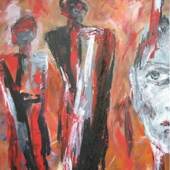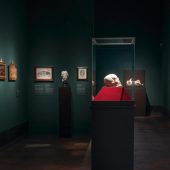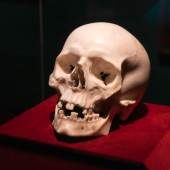How This Masterful Marble Skull Became Attributed to the Great Baroque Artist Bernini
-
Ausstellung30.10.2014 - 28.10.2021
Curator and TEFAF vetting committee member Claudia Kryza-Gersch shares the journey of this rediscovery in Dresden’s Skulpturensammlung
Claudia Kryza-Gersch, curator of Renaissance and Baroque sculpture and member of one of TEFAF’s vetting committees, joined Dresden’s Skulpturensammlung (Sculpture Collection) in 2017, setting out to catalogue the bronzes of this important collection. “Little did I know that the Skulpturensammlung is full of unnoticed treasures, and so far, I stumbled from one discovery to the next, without having time to work on that catalogue,” Kryza-Gersch shares. One of these unnoticed treasures is Death’s Head, a remarkably realistic, life-sized marble skull, worked fully in the round, including the underside. It had been on loan to the Kunstgewerbemuseum (Museum of Decorative Arts) in castle Pillnitz since 2006 and was described as “Italian, around 1700.” The first time the curator saw the skull in person was in the conservation lab when it was being considered for an upcoming exhibition, an experience that left her feeling awestruck by the skull’s quality. “We were all convinced that this must be the work of a great artist, and since we knew from our documentation that it was bought in Rome in 1728, one of us jokingly suggested that it might be by Bernini.” The marble skull indeed turned out to be a work once thought lost by the sculptor and architect Gian Lorenzo Bernini (1598-1680).
Bernini’s Death’s Head is now on display in the exhibition Bernini, the Pope and Death (through 21 November, 2021), which explores the themes of the preciousness of life and the power of art, and presents the skull together with other works showcasing the artist’s creations under the pontificate of Pope Alexander VII. Here, Kryza-Gersch shares the details of her work and research to uncover the story of the skull and identifying its maker.
Establishing a picture-perfect provenance
Archival research played an essential part in discovering the skull’s story—in particular, its provenance, for which the museum’s documentation provided a starting point. It was recorded that the skull was part of an acquisition of 160 pieces of antique sculpture and four 17th-century works by the great art patron Augustus the Strong, Elector of Saxony and King of Poland (1670-1733). These works had been brought together by Cardinal Flavio Chigi (1631-1693) in the second half of the 17th century and were purchased en bloc from his heirs in 1728. Kryza-Gersch came across a letter written by Raymond le Plat, the art agent of Augustus, describing that the purchase of the Chigi collection would include also “Un tête du mort du Bernini,” but the artist’s name was seemingly forgotten in Dresden over time. “As the Chigi collection is mainly one of antiquities, it had so far been studied only by archeologists, which is why the mentioning of a skull by Bernini did not arouse great interest,” Kryza-Gersch explains. She pursued the skull’s history in the inventories of the Chigi family, which can be consulted – “luckily, for we were in the midst of the second lock down” – on the website of the Vatican Apostolic Archive. “In these records, it was possible to follow the skull all the way back to the inventory of Cardinal Flavio Chigi’s art collection, compiled in 1692, where one can find the entry: “Una testa di morto di marmo di Carrara fatta del Bernini.”
Kryza-Gersch then approached the object from the perspective of Bernini’s oeuvre. It had been known that Bernini was commissioned a skull of marble for Pope Alexander VII (1599-1667) as a poignant reminder of the inevitability of death, which lured close around the corner in the 17th century. The then newly-elected pope was born Fabio Chigi and was none other than the uncle of Cardinal Flavio Chigi. “It was then fairly easy to put all the pieces of the puzzle together: Bernini made the skull in 1655 for Alexander VII, and Flavio Chigi inherited it after the pope’s death. It remained in the family’s possession until it was sold to Dresden: a picture-perfect provenance.”
While documentation plays an important role in art historical research, Kryza-Gersch shares that it can also be confusing, and documents should be read carefully. “During my research, I came across a reference according to which the sculptor Baldassare Mari was paid for a skull made for the pope. Since Mari was one of the many assistants working in Bernini’s workshop, I had to ask whether the Dresden Death’s Head was perhaps not by Bernini but by one of his collaborators.” Luckily, Mari’s work can be found in Dresden since he restored many of the antique sculptures in Flavio Chigi’s collection, which provided an opportunity for Kryza-Gersch to study the artist’s qualities. “Restoring in the 17th century meant adding heads, torsos, limbs—basically whichever elements were missing from a sculpture. When I looked at these additions, it became clear that Mari was a good artisan, but not more. It seemed to me inconceivable that he should be the creator of the brilliant Death’s Head.” As it turned out, Mari did make a second skull for Alexander VII, who gifted it to his nephew Flavio. “The one by Bernini, he kept for himself, of course.”
-
25.03.2021Psychological Portraiture by Pablo Picasso Picasso’s powerful seated portraits of...
-
23.06.2020 - 30.06.2021SWISS MADE UNLOCKEDA BRAND-NEW MULTI-DISCIPLINARY ONLINE AUCTIONOVER 200 LOTS | 13 COLLECTING...
-
01.12.2020 - 14.12.2020Partnership Celebrates Sotheby’s Festival of Wonder Luxury Sale Series,Including Live and...
-
Der Künstler lebte in dem kleinen Ort Hertogenbosch, also weit weg von jeder Kulturstadt. Die...
-
15.03.2025 - 20.03.2025Die TEFAF (The European Fine Art Fair) ist eine der weltweit renommiertesten Kunst- und...
-
30.10.2014 - 28.10.2021
.


















